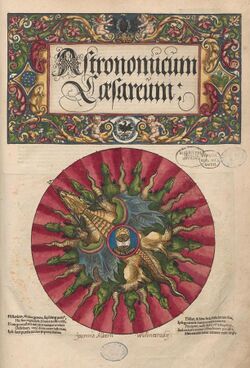Astronomy:Astronomicum Caesareum
Astronomicum Caesareum (Astronomy of the Caesars;[1] also translated as The Emperor's Astronomy[2]) is a book by Petrus Apianus first published in 1540.
Astronomicum was initially published in 1540. Charles V, Holy Roman Emperor, and Ferdinand II of Aragon commissioned the work.[3] It was printed at Apianus's press in Ingolstadt, Bavaria, and took eight years to produce.[4][5] It expanded and changed when reprinted; the final version has 55 leaves.[2] Apianus evidently changed his plans while producing a single edition. A volvelle in one version of Astronomicum has "an entirely irrelevant base of an astrolabe" underneath, suggesting that he considered creating one and then abandoned the idea.[6]
Twenty-one of its 36 woodcuts are volvelles.[1] Astronomicum's volvelles rely on a geocentric model of the universe.[5] However, despite the false science on which they depended, knowledgeable readers could still use them to predict planetary movements.[5] Nicolaus Copernicus published De revolutionibus orbium coelestium shortly after Astronomicum appeared, which began a transition to heliocentrism as the standard astronomical model.[2]
Although other 16th-century books used volvelles, Astronomicum's are distinctive because they take precedence over the book's text, as opposed to serving as illustrations.[4] According to Ronald Brashear and Daniel Lewis, Astronomicum is "really a scientific calculating instrument as much as a book".[5]
A 1997 study reported that 111 copies of the book existed.[7] Tycho Brahe bought one copy in 1599 which is in the collection of a library in Gotha, likely Forschungsbibliothek Gotha (de).[8]
Notes
- ↑ 1.0 1.1 Helfand 2002, pp. 20–21.
- ↑ 2.0 2.1 2.2 Christianson 2012, p. 83.
- ↑ Helfand 2002, p. 20.
- ↑ 4.0 4.1 Helfand 2002, p. 81.
- ↑ 5.0 5.1 5.2 5.3 Brashear & Lewis 2001, p. 8.
- ↑ Gingerich 1994, p. 294.
- ↑ Brashear & Lewis 2001, p. 81.
- ↑ Price, Derek J. de Solla (6 October 1967). "The Book as a Scientific Instrument". Science 158 (3797): 102–104. ISSN 0036-8075.
Sources
- Brashear, Ronald; Lewis, Daniel (2001). Star Struck: One Thousand Years of the Art and Science of Astronomy. Huntington Library; University of Washington Press. ISBN 0-295-98097-4. OCLC 45393510. https://archive.org/details/starstruckonetho0000bras.
- Christianson, Scott (2012). 100 Diagrams that Changed the World: From the Earliest Cave Paintings to the Innovation of the iPod. Plume. ISBN 978-0-452-29877-4. OCLC 778419237. https://archive.org/details/100diagramsthatc0000chri_n0r9.
- Gingerich, Owen (1994). "Early Astronomical Books with Moving Parts". A History of Book Illustration: 29 Points of View. Scarecrow Press. ISBN 0-8108-2742-5. OCLC 29595405. https://archive.org/details/historyofbookill0000unse_z6n3.
- Helfand, Jessica (2002). Reinventing the Wheel. Princeton Architectural Press. ISBN 1-56898-338-7. OCLC 48817585. https://archive.org/details/reinventingwheel0000helf.
External links


